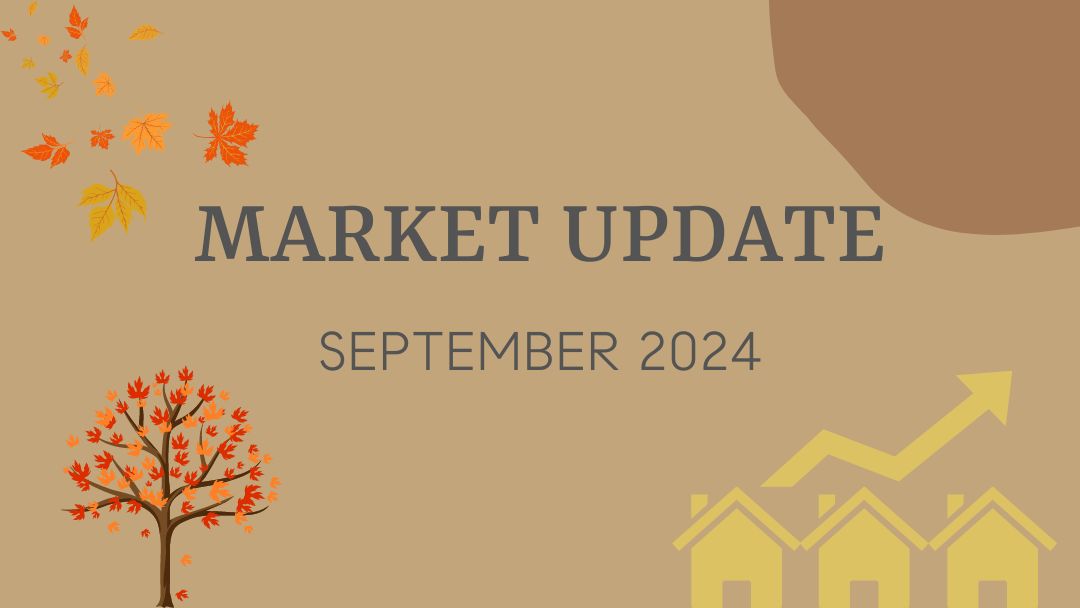The high interest rate regime that began in March of 2022 was finally reversed when the Federal Reserve lowered it’s benchmark rate by 0.50% on September 18th, the first decrease in four years. The move was anticipated but the ‘supersized’ half-point rate cut was certainly welcomed by many in the real estate industry. How that rate cut reflects the state of the economy, what it means for mortgage interest rates, and how these factors will impact the real estate market moving forward is the focus of my September 2024 real estate market update.
Current Market Conditions
Of course the headline news is the recent Fed rate cut, but there’s more behind that move. The August Consumer Price Index report, released the week before the Fed Open Market Committee (FOMC) meeting, showed a lift in prices of just 0.2% which put the trailing year total at just 2.5%, within striking distance of the Fed’s target of 2%.
Notably, the core index was up 0.3% from the prior month, which was the biggest increase in four months. As I’ve discussed in this report in the past, the core index excludes volatile food and energy prices and shelter costs compose nearly 70% of the index. Shelter costs were up 0.5%, the most since the beginning of 2024. So while inflation still ticked up slightly, a majority of those increases came from ongoing high rent and rent equivalent costs for home owners.

The recent August jobs report showed a modestly sluggish 142,000 new jobs added. This was less than expected, but despite these somewhat disappointing numbers, the national unemployment rate dropped slightly to 4.2%. The more troubling news was a downward adjustment of the June and July job creation numbers by 86,000.

The CPI data showing inflation well in check, along with the slowing market for jobs gave the Fed the cover they needed to make a larger than expected half-point interest rate reduction. In his comments following the committee meeting, Fed Chair Jerome Powell acknowledged that the Fed might have reduced rates a quarter point during their August meeting had the July jobs data been available at that time. Regardless of the timing, it’s clear that the Fed has shifted it’s focus away from fighting inflation and toward support ongoing job and economic growth.
There’s also some useful data that has come out since the Fed announced the new interest rate regime. Another popular gauge of inflation, the Personal Consumption Expenditures (PCE) Index, was released today and provided even further evidence of declining inflation. Consumers paid just 2.2% more for products through the year ending in August. This was down from 2.5% in July and below a 2.3% increase expected by economists. This is a signal that consumers are curtailing their spending in light of the weakening labor market.
What’s Next For The Fed?
At the September FOMC meeting the Fed not only cut rates by a half-point, but also forecast expected rate levels over the next couple of years. You should always take these forecasts with a grain of salt as they are subject to change based on economic data. Regardless, the Fed is forecast to cut rates another half-point by the end of 2024, a full point throughout 2025, and another half-point in 2026. In all, this totals an additional 2% in cuts over the next 24 months.
The PCE data from today further supports that view, and also points to a possible acceleration of rate reductions before the end of 2024. The stock market has responded favorably to this news setting new record highs in anticipation that the Fed has pulled off the rare trick of taming inflation without triggering a recession, also referred to as a ‘soft landing’. The market seems to be pricing in future rate reductions and expects that lower borrowing costs will lead to increased corporate investment and ongoing job growth.
The Fed’s Impact on Mortgage Rates
As I’ve frequently mentioned in the past, the Fed funds rate is not directly correlated to mortgage interest rates, though there tends to be a close association. Mortgage rates are more impacted by the bond market, particularly the 10-year treasury bond. As bond yields decline investors look for better performing assets and move capital into mortgage-backed securities (MBS). With more buyers for these securities, banks do not need to offer as strong returns, and can thus lower the rate of return, resulting in lower interest rates for borrowers.
While mortgage rates have already been declining for the past 6 weeks or so in anticipation of a rate cut, the half-point cut from last week is a signal that the Fed believes that inflation is well in hand, and we are looking forward to an extended period of lower borrowing costs. Combined with the comments regarding expected rate cuts over the next 24 months, lenders are likely to feel confidence to lower rates even further in the next couple of months.
While 30-year mortgages are now averaging close to 6% a consensus is developing that rates will be near 5.5% by the end of 2025, and possibly approaching 5% by the end of 2026. Of course this is all subject to change if inflation picks up again or if the economy goes into recession.
The Impact On Real Estate
Housing costs remain one of the largest contributors to ongoing inflationary pressure and the past few years of high mortgage interest rates have not reduced shelter costs. There are a number of reasons for this.
First, and most fundamentally, is a lack of housing units across the country, and particularly in the inner east Bay Area. As long as demand outstrips supply, prices will remain elevated regardless of interest rates. This is why the shelter category of the consumer price index has remained high, and also why it is such a significant proportion of the index: housing expenses account for at least 30% of annual income for a majority of Americans.
Another important factor that has contributed to ongoing high real estate prices is homeowner lock-in. Many property owners refinanced their mortgages at sub 3% rates and are loathe to give up that cheap money. To sell a home and then buy a new property at a 6%+ rate is a gut punch, so many sellers are waiting for rates to decline further before selling. As long as sellers are staying put in their homes there is less inventory available for all the willing buyers in the market which elevates property values.
In my estimation, buyers don’t think much about mortgage rates. They do consider their cash flow and whether their mortgage payment will be affordable relative to their monthly income, but the specific percentage number is not what they worry about.
Sellers, on the other hand, are comparing mortgage rates for a new purchase relative to their existing rate. This is where psychology plays a larger factor. I expect that when rates approach 5% it is going to unlock a good amount of inventory as sellers will feel more comfortable giving up their low, refinanced rates.
Conclusion
However you look at it, declining interest rates are good for the real estate market. Lower borrowing costs offer buyers the opportunity to purchase more home for the same down payment, and for sellers to give up their low rates and move to properties that are more suited for their current life circumstances.
While you can’t time the market, there is every reason to believe that mortgage interest rates will continue to decline over the coming months and years.
This, however, is not a reason to wait. As rates go down, more buyers will enter the market, pushing home values even higher. This is bad for buyers as well as for sellers looking to purchase. The best option is to transact as soon as it makes sense for your personal situation. It may even be worth considering an adjustable rate mortgage which typically offers a lower starter rate for five or seven years before moving to the market rate.
As always, if you have any questions on how to frame the decision moving forward, please reach out to me. I have lender referrals for buyers to help you better evaluate your purchasing power, and can provide sellers with a free market analysis on the current value of your home.
I’m excited to see rates coming down as I believe this will enable the dream of home ownership for more people which is a key wealth building tool and can help you secure your future and that of your family for generations to come. I look forward to hearing from you soon!




